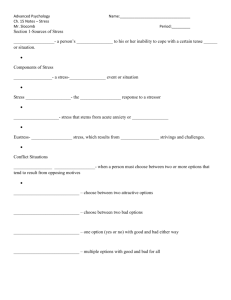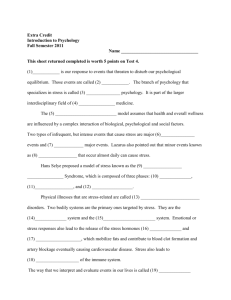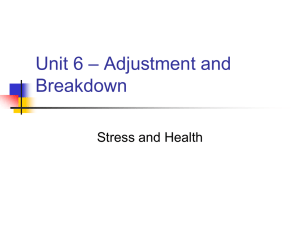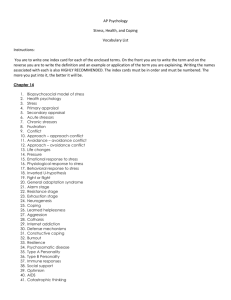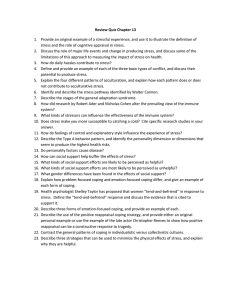Stress, Health, & Coping
advertisement
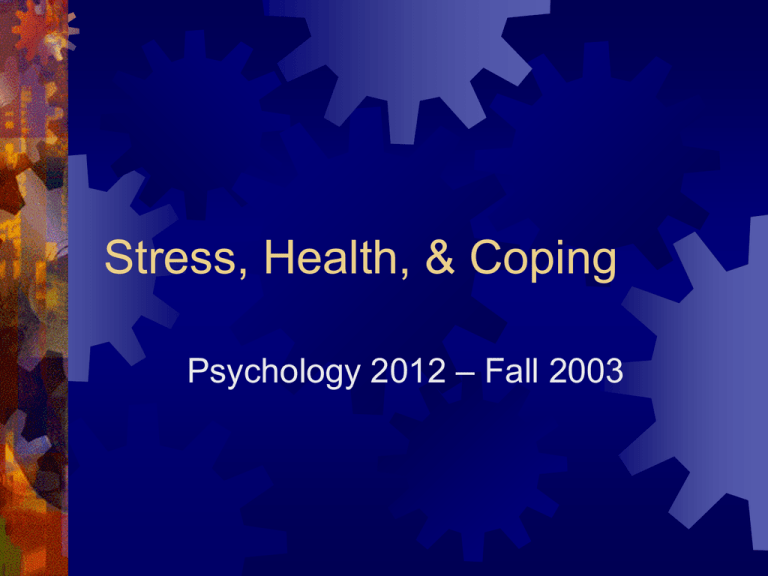
Stress, Health, & Coping Psychology 2012 – Fall 2003 Introduction: What Is Stress? Stress – a negative emotional state occurring in response to events that are perceived as taxing or exceeding a person’s resources or ability to cope Whether or not we experience stress largely depends on: 1. 2. Our cognitive appraisal of an event and The resources that we have to deal with the event Health psychology – the branch of psychology that studies how psychological factors influence health, illness, medical treatment, and health-related behaviors Health psychologists are guided by the biopsychosocial model – states that health and illness are determined by the complex interaction of biological, psychological, and social factors The Biomedical Model The Biopsychosocial Model Introduction: What Is Stress? Sources of Stress Life is filled with potential stressors – events or situations that produce stress Life events and change To measure the amount of stress people experienced, early stress researchers Holmes and Rahe developed the Social Readjustment Rating Scale Includes 43 life events that require some level of adaptation Each life event is assigned a numerical rating that estimates its relative impact in terms of life change units Holmes and Rahe found that people who had more than 150 life change units within a year had an increased rate of physical or psychological illness Introduction: What Is Stress? Life events and change Several problems with the life events approach have been identified 1. 2. 3. The link between scores on the Social Readjustment Rating Scale and the development of physical and psychological problems is relatively weak In general, these scores are not very good predictors The Social Readjustment Rating Scale does not take into account a person’s subjective appraisal of an event, response to that event , or ability to cope with the event The life events approach assumes that change in itself, whether good or bad, produces stress The Social Readjustment Rating Scale is still used in stress research, and there have been recent efforts to update it to take into account the influences of gender, age, marital status, and other characteristics Introduction: What Is Stress? Daily hassles Psychologist Lazarus emphasized the importance of cognitive appraisal in the stress response He demonstrated the significance of everyday hassles in producing stress Lazarus and colleagues developed a scale to measure daily hassles – everyday occurrences that annoy and upset people One reason that daily hassles can take a toll on us is that such minor stressors are cumulative Introduction: What Is Stress? Conflict: torn between two choices Another source of stress is conflict – feeling pulled between two opposing desires, motives, or goals Three basic types of conflicts are described in terms of approach and avoidance An individual is motivated to approach desirable or pleasant outcomes and to avoid undesirable or unpleasant outcomes 1. Approach-approach conflict – represents a win-win situation; you’re faced with a choice between two equally appealing outcomes 2. Avoidance-avoidance conflict – a more stressful conflict; you are required to choose between two unappealing or undesired outcomes 3. Approach-avoidance conflict – most common conflict; a single goal has both desirable and undesirable aspects – faced with an approach-avoidance conflict, people often vacillate, unable to decide whether to approach or avoid the goal Introduction: What Is Stress? Social and cultural sources of stress When people live in an environment that is inherently stressful, they often experience ongoing, or chronic, stress People in the lowest socioeconomic levels of society tend to have the highest levels of psychological distress, illness, and death Stress can also result when people encounter different cultural values Physical Effects of Stress: The Mind-Body Connection Stress can indirectly affect a person’s health by prompting behaviors that jeopardize physical well-being Stress can directly affect physical health by altering bodily functions, leading to symptoms, illness, or disease Physical Effects of Stress: The Mind-Body Connection Stress and the endocrine system Walter Cannon: stress and the fight-or-flight response Fight-or-flight response – a rapidly occurring chain of internal physical reactions that prepare people either to fight or take flight from an immediate threat First described by American physiologist Cannon, who found that the fight-or-flight response involves both the sympathetic nervous system and the endocrine system With the perception of a threat, the hypothalamus and lower brain structures activate the sympathetic nervous system, Which stimulates the adrenal medulla to secrete hormones called catecholamines – including adrenaline and noradrenaline Physical Effects of Stress: The Mind-Body Connection Stress and the endocrine system Hans Selye: stress and the general adaptation syndrome Canadian endocrinologist Selye was a pioneer in stress research He found that rats exposed to prolonged stressors had the same pattern of physical changes: First the adrenal glands became enlarged Second, stomach ulcers and loss of weight occurred Third, there was shrinkage of the thymus gland and the lymph glands, two key components of the immune system Physical Effects of Stress: The Mind-Body Connection Stress and the endocrine system The general adaptation syndrome is Selye’s term for the three-stage progression of physical changes that occurs when an organism is exposed to intense and prolonged stress During the initial alarm stage, intense arousal occurs as the body mobilizes internal physical resources to meet the demands of the stress-producing event In the resistance stage, the body actively tries to resist or adjust to the continuing stressful situation If the stress-producing event persists, the exhaustion stage may occur General Adaptation Syndrome Alarm: a threat mobilizes body resistance to stress Resistance: stress resistance reaches its maximum Exhaustion: The organism's resources for dealing with stress are exhausted -- stress resistance drops off General Adaptation (Selye, 1956) Physical Effects of Stress: The Mind-Body Connection Stress and the endocrine system Selye found that prolonged stress activates a second endocrine pathway that involves the hypothalamus, the pituitary gland, and the adrenal cortex In response to a stressor, the hypothalamus signals the pituitary gland to secrete a hormone called adrenocorticotropic hormone (ACTH) ACTH stimulates the adrenal cortex to release stressrelated hormones called corticosteroids The most important of these is cortisol In the short run, the corticosteroids help protect the body against the harm caused by stressors Physical Effects of Stress: The Mind-Body Connection Stress and the immune system Stress can diminish the effectiveness of the immune system – the body’s system for detecting and battling invaders such as bacteria, viruses, and tumor cells The most important elements of the immune system are lymphocytes – the specialized white blood cells that fight bacteria, viruses, and other problems The new field of psychoneuroimmunology Psychologist Ader teamed up with immunologist Cohen and demonstrated that immune system functions could be influenced by the brain Ader and Cohen’s study helped establish a new interdisciplinary field (psychoneuroimmunology) which is the scientific study of interconnections among psychological processes, the nervous and endocrine systems, and the immune system Physical Effects of Stress: The Mind-Body Connection Stress and the immune system Psychoneuroimmunologists have made many important discoveries 1. 2. 3. The central nervous system and the immune system are directly linked via sympathetic nervous system fibers The surfaces of lymphocytes contain receptor sites for neurotransmitters and hormones, including catecholamines and cortisol Lymphocytes themselves produce neurotransmitters and hormones Individual Factors That Influence Our Response to Stress Psychological factors Personal control – research consistently shows that having a sense of control over a stressful situation reduces the impact of stressors and decreases feelings of anxiety and depression If you feel you can control a stressor by taking steps to minimize or avoid it, you will experience less stress, Both subjectively and physiologically In contrast, feeling a lack of control over events produces all the hallmarks of the stress response The perceptions of personal control in a stressful situation must be realistic to be adaptive Individual Factors That Influence Our Response to Stress Psychological factors Explanatory style: optimism vs. pessimism Psychologist Seligman found that how people characteristically explain their failures and defeats makes the difference People who have an optimistic explanatory style tend to use external, unstable, and specific explanations for negative events People who have a pessimistic explanatory style us internal, stable, and global explanations for negative events In contrast to an optimistic explanatory style, a pessimistic explanatory style is associated with more stress and poorer physical health Individual Factors That Influence Our Response to Stress Psychological factors Chronic negative emotions Friedman and Booth-Kewley reported that people who are habitually anxious, depressed, angry, or hostile are more likely to develop a chronic disease Chronically tense, angry, and unhappy people experience more stress than do happier people They also report more frequent and more intense daily hassles than people who are generally in a positive mood And they react much more intensely, and with far greater distress, to stressful events Individual Factors That Influence Our Response to Stress Psychological factors Type A behavior and hostility Cardiologists Meyer Friedman and Ray Rosenman described the Type A behavior pattern In contrast, people who were more relaxed and laid back were classified as displaying the Type B behavior pattern The most critical health-compromising component of Type A behavior is hostility A behavioral and emotional style characterized by a sense of time urgency, hostility, and competitiveness He tendency to feel anger, annoyance, resentment, and contempt, and to hold negative beliefs about human nature in general High hostility levels increase the likelihood of dying from all natural causes, including heart disease and cancer Hostile Type A’s tend to react more intensely to a stressor than other people do Because of their attitudes, hostile men and women tend to create more stress in their lives Type A Behavior Hostility Anger Impatience Competitiveness Time Urgency Type A & Heart Disease (Miller, et.al, 1991) Individual Factors That Influence Our Response to Stress Social factors Social support – the resources provided by other people in times of need How social support benefits health – social support may benefit our health and improve our ability to cope with stressors in several ways 1. The social support of friends and relatives can modify our appraisal of a stressor’s significance Including the degree to which we perceive it as threatening or harmful 2. The presence of supportive others seems to decrease the intensity of physical reactions to a stressor 3. Social support can influence our health by making us less likely to experience negative emotions Individual Factors That Influence Our Response to Stress Social factors Relationships with others also can be a significant source of stress When other people are perceived as being judgmental, their presence may increase the individual’s physical reaction to a stressor Stress may also increase when well-meaning friends or family members offer unwanted or inappropriate social support Individual Factors That Influence Our Response to Stress Social factors Gender differences in the effects of social support Women may be particularly vulnerable to some of the problematic aspects of social support Women are more likely than men to serve as providers of support, which can be a very stressful role Women may be more likely to suffer from the stress contagion effect Becoming upset about negative life events that happen to other people they care about Men tend to rely heavily on a close relationship with their spouse, placing less importance on relationships with other people Because of their smaller social network, men are more vulnerable to social isolation after the loss of a spouse Coping: How People Deal With Stress Two ways of coping: problem- and emotionfocused coping Coping involves efforts to change circumstances, or your interpretation of circumstances, Coping tends to be a dynamic, ongoing process When coping is effective, we adapt to the situation, and stress is reduced To make them more favorable and less threatening Maladaptive coping can involve thoughts and behaviors that intensify or prolong distress or that produce selfdefeating outcomes Adaptive coping responses serve many functions They involve realistically evaluating the situation and determining what can be done to minimize the impact of the stressor Coping: How People Deal With Stress Two ways of coping: problem- and emotionfocused coping Adaptive coping responses serve many functions They involve realistically evaluating the situation and determining what can be done to minimize the impact of the stressor They involve dealing with the emotional aspects of the situation They are directed toward preserving important relationships during stressful experiences Psychologists Lazarus and Folkman described two basic types of coping Problem-focused coping – refers to coping efforts primarily aimed at directly changing or managing a threatening or harmful stressor Emotion-focused coping – refers to coping efforts primarily aimed at relieving or regulating the emotional impact of a stressful situation Coping: How People Deal With Stress Problem-focused coping strategies: changing the stressor Problem-focused coping strategies represent actions that have the goal of changing or eliminating the stressor When people use aggressive or risky efforts to change the situation, they are engaging in confrontive coping When people rationally analyze the situation, identify potential solutions, then implement them, they are engaging in planful problem solving Coping: How People Deal With Stress Emotion-focused coping strategies: changing your reaction to the stressor When the stressor is one over which we can exert little or no control, we often focus on dimensions of the situation that we can control; The emotional impact of the stressor on us Coping: How People Deal With Stress Emotion-focused coping strategies: 1. 2. 3. 4. 5. The escape-avoidance strategy involves shifting your attention away from the stressor and toward other activities Seeking social support involves turning to friends, relatives, or other people for emotional, tangible, or informational support In distancing, you acknowledge the stressor but attempt to minimize or eliminate its emotional impact Denial is a refusal to acknowledge that the problem even exists Positive reappraisal occurs when you not only try to minimize the negative emotional aspects of the situation, but also try to create positive meaning by focusing on personal growth People usually rely on multiple coping strategies in stressful situations Coping: How People Deal With Stress Culture and coping strategies Culture seems to play an important role in our choice of coping strategies Members of individualistic cultures tend to emphasize personal autonomy and personal responsibility in dealing with problems Thus, they are less likely to seek social support in stressful situations than are members of collectivistic cultures Individualistic individuals favor problem-focused strategies In collectivistic cultures, however, a greater emphasis is placed on controlling personal reactions to a stressful situation Rather than trying to control the situation itself Thus, these cultures favor emotion-focused strategies Causes of Death Before 65 (Powell, et.al, 1986)
